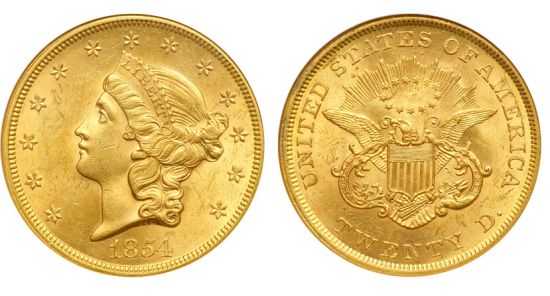United States 1854 20 dollars
Authorization
[1]One of the consequences of the immense discoveries of gold in California was an inordinate increase of gold bullion coming into Philadelphia for coinage. Authorities felt that large-scale domestic and international transactions payable in gold should be more compact form than eagles or smaller denominations. Accordingly, Representative James P. Iver McKay (D.-N.C.) was persuaded to introduce an amendment to his Gold Dollar bill, February 1849 and passed on March 3, 1849, which would authorize coinage of $20's, to be called Double Eagles. These were to weigh 516 grams = 33.436 grains., a little over a troy oz. each and would be roughly comparable in value to Latin American denominations. Referred to as a Double Eagle, it is a gold coin of the United States with a denomination of $20. (Its gold content of 0.9675 troy oz was worth $20 at the then official price of $20.67/oz).
Proofs of the series are excessively rare, with perhaps two known of the 1850 and 1854. Proofs were first placed on public sale in 1858, and three or four exist with this historic date. These first proof sets included the copper-nickel cent, silver half dime, dime, quarter, half dollar and dollar as well as the gold dollar, quarter eagle, half eagle, eagle and double eagle. The sets sold for $46 and appear today to have been a fantastic bargain. In the 1850's, however, few working class Americans, merchants or professional people could afford to tie up the equivalent of five weeks' wages that a $20 coin represented.
Obverse
James Barton Longacre used a similar Liberty design for both the dollar and $20, a handsome woman's head displaying a meticulous nose and wearing a pearl-bordered diadem inscribed LIBERTY. It was modeled after an ancient Greco-Roman sculpture, the Crouching Venus.
Reverse
James Barton Longacre's reverse reflected his training as a two-dimensional engraver. Based on the Great Seal of the United States, it depicts a spread eagle with a shield on its breast, 13 stars in an oval with rays above. The nation's name appears above, the denomination expressed as TWENTY D. below.
Recorded Mintage: 757,899.
Specification: 516 grains (33.436 grams), 1 1/3" (34 millimeters) diameter, 90% gold, silver not over 5%, rest copper; reeded edge.
Catalog reference: KM 74.1.
- Alexander, David T., Coin World Comprehensive Catalog & Encyclopedia of United States Coins, Sidney, OH: Amos Press, 1995.
- Breen, Walter H., Walter Breen's Complete Encyclopedia of U. S. and Colonial Coins, New York: Doubleday, 1987.
- Friedberg, Arthur L. and Ira S. Friedberg, Gold Coins of the World, From Ancient Times to the Present, 9th ed., Clifton, NJ: Coin and Currency Institute, 2017.
- Harper, David C., ed., North American Coins & Prices: A Guide to U. S., Canadian and Mexican Coins, 17th Ed., Iola, WI: Krause Publications, 2007.
- Yeoman, R. S., and Kenneth Bressett (ed.), A Guide Book of United States Coins, 65th Ed., Atlanta, GA: Whitman Publishing, 2011.
Link to:
- 1853-O 20 dollars
- 1854-O dime
- 1854 half dollar
- 1854 gold dollar, type 2
- 1854 3 dollars
- 1854-C 5 dollars
- 1854-O 10 dollars
- 1855-S 20 dollars
- Coins and currency dated 1854



